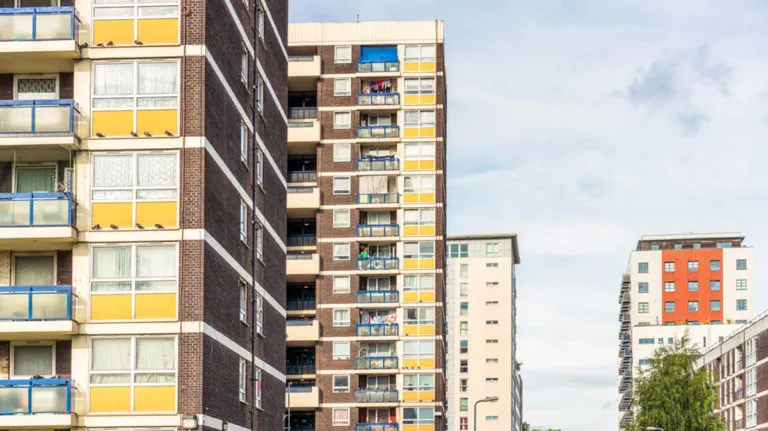33,000 people had their say on social housing. Sixteen will ensure they’re heard. One of them shares his view on how.
Published: by Guest blog

Guest blog by Rob Gershon
I’ve just got home from the third meeting of the Shelter commission on the future of social housing, and I’m trying to sift through the information we’ve discussed today and my thoughts and feelings about it, so that I can try and summarise where the commission has come from, where it is, and where it might be going.
This isn’t quite as simple as it sounds. From the outset, the commission’s meetings haven’t been minuted on a line-by-line basis. This allows everyone to speak freely on how we feel about the issues being raised, included and discussed, knowing they won’t be reported outside the room. This makes coming away and talking about it slightly more challenging and means I’ve had to show someone else my workings before you can read them.
The first commission meeting was on 5 March 2018, and although I had blogged ahead of it about my hopes, that was a different thing to turning up at the Shelter offices, meeting everyone and starting to thrash out what the commission is for. I was invited onto the commission as a social tenant, a full time carer, someone who has had the privilege of getting my thoughts and arguments heard about social housing, fairly well-read inside housing sector circles, tangentially as a late-developing housing policy nerd.
Within 20 minutes of arriving for that first meeting, I was walking to a sandwich shop with Ed Miliband. It was a surreal beginning, and I’m still sure that my mumbled joke about having to choose a bacon sandwich either went unheard or was carefully ignored. I got to have a pretty long chat about how I’d ended up on the commission, from talking to housing people, solicitors and politicians about bedroom tax, to being involved in Social Housing Under Threat (SHOUT) – the campaign which produced the unanswerable economic case for social housing back in 2015, which Ed remembered reading while he was in charge of the Labour party.

On the train on the way to that first meeting I couldn’t think of a single reason why anybody had asked me to be a commissioner. This nagging self-doubt has stuck with me to some extent, through all the stuff I’ve done with the commission since. But I know it’s important for tenants to be there; our input has guided the conversation as much as, if not more than, other commissioners.
It’s not that I don’t feel I know enough stuff. The work I’ve done over the last couple of years with Housing Quality Networks’ Residents’ Network, and before that the self-inflicted reading on policy and practice, have left me knowing more than I ever wanted to about broader housing issues, and more specifically the frankly bewildering range of different approaches tenants and landlords take to co-regulation, co-production and scrutinising policies and services.
It sounds odd to say it, but the commission is the least housing-y thing I’ve ever done. Although most of the commissioners have come from well-known organisations and backgrounds, we’re all there as individuals, not representatives for any of our employers, campaign groups or political parties.
There are plenty other ongoing reviews of social housing from within the housing bubble, not least the much-anticipated Green Paper from the Ministry of Housing, Communities and Local Government, but Shelter’s commission has brought together a more disparate set of views and experiences. This means there’s some catching up to be done on specific housing details, but there are a wealth of other talents and perspectives about neighbourhoods, communities, the law, how commissions work, a bit of politics, regulation.
Using a range of research, evidence submissions and the results of a mass online collaboration, Shelter’s commission on the future of social housing will deliver a landmark report to the government this autumn.
Some of the response to these issues come from Shelter’s ‘Big Conversation‘ online survey, which turned out to be a lot bigger than the significant Shelter teams working on collating everything had expected, with nearly 32,000 responses from the public, of which a quarter – a bit over 7,600 responses, came from social tenants.
Other qualitative and quantitative data has come through research being conducted by Britain Thinks – some of the commission’s researchers and number-crunchers, in substantive work on views about, perceptions of, and measure of how much everyone wants to live in social housing.
There’s other input, too, detailed and extensive feedback from a range of bodies big and small who have made submissions to the commission, stuff collected directly at events where tenants and staff in housing have had their say about what they want for the future.
This is just stuff. It’s a lot of stuff but it doesn’t mean anything without context. When the commission’s final report is released in November 2018, the stuff will form part of the discussions and debates that begin about numbers, statistics and scale, but it’s still quite a lot of what, and not a great deal of why.
During the third meeting, the mountain of information collated by the commission and the busy teams from Shelter had started to take shape. It’s still a long way from forming the final commission report, but it has started to spark conversations about what should appear and in what order and with what priority.
In addition to the three commissioner meetings, in depth interviews and various other bits and bobs, commissioners also took part in a private meeting at Grenfell United, the organisation that includes one of our commissioners, Grenfell survivor Ed Daffarn, and a public meeting in North Kensington, and from both of these events came two strong messages.
The first was that tenants do not want to be treated as second-class citizens, especially by their landlords. The second was that there should be improved regulation. This is an area which can be a bit technical and dry, but I’m more convinced than ever that there is a need for meaningful changes to how regulation operates, and for this to inform part of the commission’s report.
So, what’s next? July and August are when the ‘Citizen’s Juries’ are forming part of the finalising of feedback from the public, in five locations. For my part, I’m shaping a specification for an additional event to look more closely at the issue of regulation, to form a more detailed and informed part of the eventual report.
To me, it feels like there are still more things to go into what the report will eventually form. There are some radical ideas being discussed in the room – many prompted by the feedback from the online survey, much of it being revised all the time by what’s happening in the real world. There’s a balance of agreement, and there are disagreements about how things are framed, but there’s a shared determination among all the commissioners to deliver a report that will be genuine lever for change.
Shelter’s commission on the future of social housing will deliver its report to the government later this year. It will include recommendations for essential changes to social housing in England. If you’d like to learn more, follow along and get involved in 2019, visit our Big Conversation pages.
Photo credit: By PaulSHird (https://www.flickr.com/photos/paulhird/35374233943)
